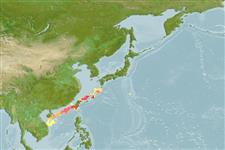Classification / Names
Common names | Synonyms | Catalog of Fishes (gen., sp.) | ITIS | CoL | WoRMS | Cloffa
Actinopterygii (ray-finned fishes) >
Pleuronectiformes (Flatfishes) >
Cynoglossidae (Tonguefishes) > Symphurinae
Etymology: Symphurus: Greek, syn, symphysis = grown together + Greek, oura = tail (Ref. 45335); megasomus: Name derived from the Greek, 'mega' for large, and 'somus' for body, referring to the large size of this species and the deep body without obvious tapering in the posterior body.
Environment / Climate / Range
Ecology
Marine; benthopelagic; depth range 200 - 640 m (Ref. 82423). Subtropical, preferred ?
Distribution
Countries | FAO areas | Ecosystems | Occurrences | Point map | Introductions | Faunafri
Northwest Pacific: Taiwan.
Length at first maturity / Size / Weight / Age
Maturity: Lm ?, range 10 - 14.342 cm
Max length : 14.7 cm SL male/unsexed; (Ref. 82423); 14.3 cm SL (female)
Short description
Morphology | Morphometrics
Dorsal
soft rays
(total): 106-111;
Anal
soft rays: 91 - 96;
Vertebrae: 55 - 58. This species is distinguished from all its congeners, except S. hondoensis and S. undatus, by its predominant 1-2-3-2-2 ID pattern. It also differs from both abovementioned species in having smaller eye (5.3-7.9% HL vs. 11.0-14.9% HL in S. hondoensis and 11.5-13.8% HL in S. undatus). This species further differs from S. hondoensis
in having 9 abdominal vertebrae (vs. 10). S. megasomus is also distinguished from S. undatus, by having higher fin-ray counts, 106-111 dorsal-fin rays and 91-96 anal-fin rays (vs. 101-105 dorsal-fin rays and 87-91 anal-fin rays) and a uniform straw-colored to dark brown ocular-side coloration (vs. freckled ocular-side pigmentation) (Ref. 82423).
This deep-water tonguefish species is known only from the continental shelf and upper continental slope off northeastern and eastern Taiwan; from 471-640 m by research vessels. Polychaetes, small crustaceans and some unidentified detritus were found in the digestive systems of fishes examined. Little else is known regarding the biology of this species (Ref. 82423).
Life cycle and mating behavior
Maturity | Reproduction | Spawning | Eggs | Fecundity | Larvae
Lee, M.-Y., H.-M. Chen and K.-T. Shao, 2009. A new species of deep-water tonguefish genus Symphurus (Pleuronectiformes: Cynoglossidae) from Taiwan. Copeia 2009(2):342-347. (Ref. 82423)
IUCN Red List Status (Ref. 115185)
CITES (Ref. 94142)
Not Evaluated
Threat to humans
Harmless
Human uses
More information
CountriesFAO areasEcosystemsOccurrencesIntroductionsStocksEcologyDietFood itemsFood consumptionRation
Age/SizeGrowthLength-weightLength-lengthLength-frequenciesMorphometricsMorphologyLarvaeLarval dynamicsRecruitmentAbundance
ReferencesAquacultureAquaculture profileStrainsGeneticsAllele frequenciesHeritabilityDiseasesProcessingMass conversion
Tools
Special reports
Download XML
Internet sources
